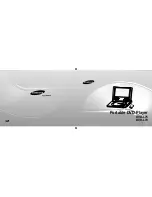
PowerSpout
TRG installation 2018
Last revised July 2018
© 2018 EcoInnovation Ltd (NZ)
Page 29
2.3. Commissioning procedures
2.3.1.
Electrical checks with covers off - before install.
These tests ensure you have completed the output connections and have no unwanted
connections through wiring faults to the PowerSpout chassis. It may be easier to perform
these checks before taking the turbine on site.
1. Connect a DC voltmeter to the DC output from the generator. Take
great care to prevent any contact with bare wires that may be at lethal
voltages. Voltage rises in proportion to RPM.
2.
Use an electric drill with a 19 mm (3/4”) socket to spin the shaft by slowly driving the
M12 bolt underneath that fixes the wet side rotor into position. Never drive the PMA
using the plastic rotor extraction knob, as you will damage the PMA.
3. Watch the voltmeter and increase the drill speed until the voltmeter reads close to
your desired operating voltage.
4. The turbine should spin freely with little noise. A slight hum is normal. The shaft will
slow and stop after about 3 seconds freewheeling.
5. Connect an ammeter (use a 10 A DC range) between the chassis ground connection
and negative output and spin the turbine to near the same speed as in step 3 above.
6. The turbine should spin freely with little noise and the ammeter must read zero.
7. Repeat steps 5 and 6 above but with the ammeter between the chassis ground
connection and positive output.
A short circuit in the wiring will cause an internal current that "brakes" the turbine (makes it
harder to turn) and so these tests will reveal wiring faults. If any of these tests show
mechanical or electrical problems, then remedy these before installing on site.
2.3.2.
Turbine RPM and voltage
The rotational speed (RPM) of the turbine depends on the pressure of the water and on
whether the turbine is correctly loaded on the electrical side of things. The water is like the
accelerator/gas pedal and the electrical output is like the brake. If you open the valves when
the wires are disconnected (open circuit) then the turbine will run away at nearly twice the
best operating RPM.
If site head is above 12 metres then do not intentionally run the turbine unloaded except for
tests. In a turbine runaway situation turn off the water supply by closing the water supply
valve(s).
Head range
Operating rpm
Runaway rpm
Comment
0 - 5 m
0-800 rpm
0-1600 rpm
Can be allowed to run
unloaded without excessive
wear or noise.
5 - 12 m
800 - 1250
1600-2500
Safe to run unloaded but will
reduce life of parts.
12 - 30 m
1250 - 2000
2500 - 4000
Do not run unloaded, apart
from testing Voc.
above 30 m
above 2000
above 4000
Consult with PowerSpout.
Open circuit voltage (Voc) in the wiring will approach three times the normal operating
voltage when the turbine is running away like this. So if your turbine is designed to work at
80V for example, the open circuit voltage may exceed 200V. This may be hazardous to
personnel and equipment.
















































